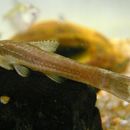pt-BR
nomes no trilho de navegação


Hisonotus és un gènere de peixos de la família dels loricàrids i de l'ordre dels siluriformes.[2]
Es troba a Sud-amèrica.[3]
Hisonotus és un gènere de peixos de la família dels loricàrids i de l'ordre dels siluriformes.
Hisonotus ist eine Gattung aus der Wels-Familie der Harnischwelse (Loricariidae) und der Unterfamilie Hypoptopomatinae. Es handelt sich um etwa 30 Arten, die im nördlichen Südamerika verbreitet sind.
Hisonotus-Arten sind kleine, etwas gedrungene Harnischwelse, die Körperlängen von 3 bis 6 cm erreichen und in ihrer Körperform an die aus der Aquaristik bekannte Gattung Otocinclus erinnern. Charakteristisch für die Gattung ist der mit zahlreichen, unregelmäßigen Knochenplatten gepanzerte Bauch. Eine Fettflosse fehlt stets. Auf dem Rostrum (Schnauze) finden sich keine vergrößerten Odonten (Zähnchen).
Bis heute wurden über 30 gültige Arten beschrieben:
Hisonotus ist eine Gattung aus der Wels-Familie der Harnischwelse (Loricariidae) und der Unterfamilie Hypoptopomatinae. Es handelt sich um etwa 30 Arten, die im nördlichen Südamerika verbreitet sind.
Hisonotus is a genus of armored catfishes native to South America. Species of Hisonotus and Curculionichthys are the only representatives of the subfamily Otothyrinae having serrae on the posterior edge of the pectoral fin spine.[1] These species are small fishes, generally found in small fast flowing streams, where they grasp to the branches and leaves of aquatic or subaquatic plants.[2] The species of this genus mostly occur in Atlantic coastal streams of southern Brazil and the Paraguay-Paraná system of southern South America.[3] They are also distributed in the Río de La Plata basin and coastal rivers of southeastern Brazil.[2]
Hisonotus and Microlepidogaster have, until recently, been considered as synonymous, although they are now recognized as separate and valid taxa.[4] In the most recent phylogenetic hypotheses, both Hisonotus and Parotocinclus are relatively basal taxa within the Otothyrini clade.[3]
There are currently 34 recognized species in this genus:
{{cite journal}}: CS1 maint: uses authors parameter (link) {{cite journal}}: CS1 maint: uses authors parameter (link) {{cite journal}}: CS1 maint: uses authors parameter (link) {{cite journal}}: CS1 maint: uses authors parameter (link) {{cite journal}}: CS1 maint: uses authors parameter (link) Hisonotus is a genus of armored catfishes native to South America. Species of Hisonotus and Curculionichthys are the only representatives of the subfamily Otothyrinae having serrae on the posterior edge of the pectoral fin spine. These species are small fishes, generally found in small fast flowing streams, where they grasp to the branches and leaves of aquatic or subaquatic plants. The species of this genus mostly occur in Atlantic coastal streams of southern Brazil and the Paraguay-Paraná system of southern South America. They are also distributed in the Río de La Plata basin and coastal rivers of southeastern Brazil.
Hisonotus es un género de pequeños peces de agua dulce de la familia Loricariidae en el orden Siluriformes. Sus 35 especies habitan en aguas cálidas o templado-cálidas del centro-este de América del Sur. La mayor especie alcanza una longitud total que ronda los 7 cm.
Este género se encuentra en ríos de aguas tropicales y subtropicales del centro-este de América del Sur, viviendo en pequeños arroyos del sudeste del Brasil, Uruguay y el nordeste de la Argentina, perteneciente a la cuenca del Plata.
Este género se subdivide en 35 especies:[1]
Hisonotus es un género de pequeños peces de agua dulce de la familia Loricariidae en el orden Siluriformes. Sus 35 especies habitan en aguas cálidas o templado-cálidas del centro-este de América del Sur. La mayor especie alcanza una longitud total que ronda los 7 cm.
Hisonotus is een geslacht van straalvinnige vissen uit de familie van de harnasmeervallen (Loricariidae).[1]
Hisonotus is een geslacht van straalvinnige vissen uit de familie van de harnasmeervallen (Loricariidae).
Hisonotus – rodzaj słodkowodnych ryb sumokształtnych z rodziny zbrojnikowatych (Loricariidae), do niedawna synonimizowany z Microlepidogaster. Obecnie obydwa rodzaje uznawane są za odrębne, poprawnie zdefiniowane taksony. Hisonotus obejmuje małe ryby, zasiedlające głównie szybko płynące wody południowej i południowo-wschodniej Brazylii oraz Paragwaju.
Gatunki zaliczane do tego rodzaju[2]:
Gatunkiem typowym jest Hisonotus notatus.
Hisonotus – rodzaj słodkowodnych ryb sumokształtnych z rodziny zbrojnikowatych (Loricariidae), do niedawna synonimizowany z Microlepidogaster. Obecnie obydwa rodzaje uznawane są za odrębne, poprawnie zdefiniowane taksony. Hisonotus obejmuje małe ryby, zasiedlające głównie szybko płynące wody południowej i południowo-wschodniej Brazylii oraz Paragwaju.
Загальна довжина представників цього роду коливається від 2,4 до 6,6 см. Зовнішністю дещо схожі на сомів з роду Otocinclus. Голова доволі велика. Очі маленькі. Морда майже округла з маленькими одонтодами (шкіряними зубчиками). Вуси короткі. Верхня щелепа трохи довша за нижню. Тулуб стрункий, трохи опецькуватий, вкрито дрібними кістковими пластинками. Черево вкрито пластинками, що розкидані довільно. Спинний плавець витягнутий назад, торкається тіла. Грудні плавці довгі з 1 жорстким променем. На задньому краї шипа присутні зазубрини. Черевні плавці значно поступаються грудним. Жировий плавець відсутній. Анальний плавець маленький. Хвостовий плавець добре розвинений, широкий, з виїмкою.
Забарвлення коричневе з різними відтінками або чорне зі світлими цяточками.
Це бентопелагічні риби. Зустрічаються у дрібних струмках з повільною течією і коричневої водою. Дно таких місць — дрібний пісок, на якому виростає рідкісна рослинність. Другий біотоп Hisonotus — лісові струмки з земляним ґрунтом, прозорою водою і густою рослинністю. У ціх місцях соми наче «висять» на опущеному у воду листі дерев.
Доволі потайливі риби. Активні вдень. Зрідка опускаються на дно, воліючи знаходитися весь час на листках рослин або на гілках чагарників. Живляться періфітоном, діатомовими і синьо-зеленими водоростями.
Мешкають у водоймах Аргентини та Бразилії, зокрема притоках Парагвая, Парани, Ла-Плати.
Необхідний ємність від 60 літрів. Основою послужить дрібний пісок темних тонів. Уздовж задньої стінки щільно один до одного висаджують рослини з довгим стеблом на кшталт валіснерії. На передній план викладають невелику корч і пару каменів. В одному з кутів потрібно закріпити зв'язку гілок наземних кущів. Опущені в воду вони створять вид природності.
Неагресивні сомики. Тримають групою від 7-10 особин. Іншими сусідами можуть стати харацинові роду нанностомусів, аксельрод і корідораси-пігмеї або хастатуси. Годують риб невеликими шматочками свіжих овочів і таблетками для рослиноїдних сомів, а також харчем тваринного походження. З технічних засобів знадобиться внутрішній фільтр середньої потужності для створення помірної течії, компресор. Температура утримання повинна становити 22-25 °C.